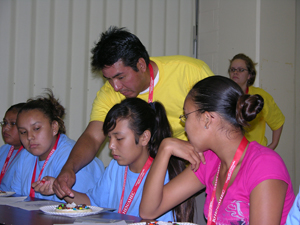 |
David Wilson, Ph.D., a post-doc fellow with the National Institutes of Health, helps, from left, Tyresha Wolfe, Mindy Blackfish, both of Winnabego, Neb., and Dominique Diaz, of Marty, S.D., make a 3-D model of a human cell out of a sugar cookie, frosting and assorted candies. |
It was music to the ears of Maurice Godfrey, Ph.D.
“That’s the kind of excitement we want to inspire. That’s what this camp is for,” said the associate professor of pediatrics for UNMC and the Munroe-Meyer Institute.
The youth was one of 23 American Indian middle school students participating in a three-day health and science fun camp July 20-22, sponsored by UNMC.
The camp is part of a $1.3 million Science Education Partnership Award (SEPA) grant Dr. Godfrey, principal investigator, and co-investigator Roxanna Jokela, director of the Rural Health Education Network at UNMC, received in 2006 from the National Center for Research Resources of the National Institutes of Health.
The purpose of the grant is to strengthen the math and science curriculum of American Indian youths on reservations in Nebraska and South Dakota.
“It’s important to introduce young people to the sciences early in hopes that it will spark a lifelong interest for some of them,” Dr. Godfrey said.
Growing up on the Navajo Indian reservation David Wilson, Ph.D., a molecular and cellular immunologist, didn’t dream he’d ever become a scientist.
“I wasn’t exposed to molecular science until I was a freshman in college,” Dr. Wilson said.
|
|
Now he is a post-doc fellow working for the National Institutes of Health.
“Ninety-percent of the ability to succeed is having the confidence to try,” Dr. Wilson said. “I came to Nebraska to tell these kids that they can do it, too. I grew up on a reservation, but I made it.”
Along with positive role models that the students can relate to, Dr. Wilson said, it’s nice to have a program like the one at UNMC to show the students the many different avenues of science.
“We’ve studied aviation, molecular science and chemistry, things they might not ever been exposed to,” he said. “There is a lot of support at NIH for the SEPA program. This is something that will be around for a long time.”